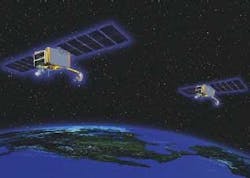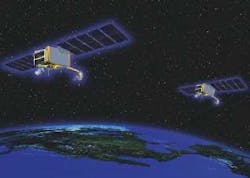Government funding of rad-hard suppliers raises accusations of favoritism
by John McHale
WASHINGTON — New U.S. Department of Defense (DOD) funding for two defense companies that specialize in radiation-hardened electronics has competitors in the rad-hard electronics business crying foul.
At issue are the low-volume rad-hard fabrication facilities of BAE Systems in Manassas, Va., and Honeywell in Clearwater, Fla. These companies, which are struggling to keep pace with the higher-volume commercial fabs, recently won 5-year DOD contracts reportedly totaling $125 million apiece.
Some of their competitors in the commercial and military space electronics business claim the funding is unfair.
Competing vendors claim the process for selecting and awarding contacts did not offer full and open competition, but rather gave preferential treatment to Honeywell and BAE. Competitors such as Peregrine Semiconductor in San Diego and Aeroflex UTMC in Colorado Springs, Colo., in fact, say this DOD investment is unfairly propping up their competition.
Proponents of government support for BAE and Honeywell, however, contend that the quality of rad-hard technology from the two companies is available nowhere else, and is vital for national security. Many of these proponents view the BAE and Honeywell rad-hard fabs, in fact, as national security assets that deserve continued government funding.
The money for BAE and Honeywell, which Congress authorizes, goes through two agencies — the Defense Threat Reduction Agency (DTRA) in Arlington, Va., and the Office of Secretary of Defense (OSD) Title III program office at the Air Force Research Laboratory (AFRL) Materials and Manufacturing Directorate at Wright-Patterson Air Force Base Ohio. DTRA advises on the design of process technology and OSD's Title III office manages the manufacturing equipment purchase. DTRA officials declined to comment for this article.
The AFRL Space Vehicle Directorate (SV) at Kirtland Air Force Base, N.M., serves as the technical advisor for the process of upgrading the fabs at BAE Systems and Honeywell.
However, AFRL/VS does not get involved in any of the business aspects and just assesses technology, says Scott Tyson, technical advisor for the Space Electronics & Protection Branch at the Space Vehicle Directorate at AFRL at Kirtland.
The government is making this move to keep these fabs alive, experts acknowledge. Most other rad-hard electronics specialists have gone out of business due to the skyrocketing costs of manufacturing, says Harald Schone, chief for Space Electronics & Protection Branch at the Space Vehicle Directorate for AFRL at Kirtland. Commercial fabs are able to handle these costs because their volume is high, whereas BAE Systems and Honeywell's rad-hard technology has one primary customer — the government, which orders in low volumes, he explains.
Today, the overall space electronics market is fractured into four distinct areas:
- upscreened/shielded COTS technology;
- radiation-tolerant electronics;
- radiation-hardened electronics; and
- strategic radiation-hardened electronics.
In 1998, export issues compounded all this when DOD suppliers saw a 40-to-60-percent decline in sales due to stiffening export rules that hurt demand.
Strategic radiation-hardened electronics is the most resistant to the effects of radiation, is the lowest-volume and most expensive of the four segments, and is acknowledged to be almost the exclusive realm of BAE and Honeywell.
Some space systems integrators say this amounts to a BAE and Honeywell monopoly, which ultimately could leave the DOD hostage to these sources without realizing the potential cost savings, says a knowledgeable source familiar with the issues.
"Some have argued since these providers have become accustomed to the government subsidies they have developed inefficient and costly practices where their costs are perceived as unrealistically high," the source says.
BAE Systems and Honeywell officials declined to speak in detail about the funding, but did offer the following statements.
"BAE Systems Information & Electronic Warfare Systems (IEWS) is extremely pleased with the U.S. Air Force's decision to support prototype capability for 0.25-micron radiation-hardened manufacturing at the IEWS Manassas, Va., facility," BAE Systems officials say. "Radiation-hardened electronics are critical to development of survivable U.S. spacecraft used in vital U.S. national space missions, and the Air Force's support will ensure continued availability of this capability for missions now in development or on the drawing boards. BAE Systems looks forward to supporting the U.S. government in developing this critical technology."
"Honeywell is pleased to be selected as a partner by the DOD to supply strategic radiation-hardened microelectronics for future government programs," says Brian Urke, general manager, Honeywell Solid State Electronics Center. "We have had a long-standing tradition as one of the key suppliers in this product area and are committed to developing next-generation products required to meet stringent strategic radiation hardened levels required by the U.S. government."
Officials at Peregrine and UTMC, however, are not shy about expressing their opinions.
"It just doesn't make sense," says Ron Reedy, chief technology officer of Peregrine. "It is very frustrating on a number of levels."
Number one, Reedy contends, the government is basically funding BAE Systems and Honeywell to compete against Peregrine and others in the rad-hard military and commercial markets. "One of the basic premises of the program is that these fabs become "commercially viable" and thus are being subsidized to compete with commercial companies," he says. Peregrine makes rad-hard products for digital, mixed-signal, analog applications using their silicon-on-insulator technology.
Government funding for BAE and Honeywell, Reedy says, is frustrating for him as a taxpayer "because they are spending reportedly $250 million on businesses that have low-volume production and therefore high cost and thus will be pressed for profitability, which is what our investors in the commercial markets demand," Reedy says.
Government funding for the two companies will not stop at $250 million, Reedy continues. Once they have their fabs running at 0.18 micron, they'll need more money to go the next generation of micron technology; it will never stop, he claims.
Proponents say U.S. defense officials are concerned that the BAE and Honeywell rad-hard technology lines might not survive without government funding. Reedy says he understands this concern, but contends that this expertise would survive even without government subsidies.
"Many rad-hard fabs have disappeared in the last ten years, however when they spend money to fix things it needs to be balanced, competitive, and coordinated throughout the rad-hard user community," Reedy says. "This effort has been the subject of great debate and it doesn't sound to us like the whole community buys into this course of action and doesn't believe it will solve the long-term problem."
The rad-hard engineering talent of BAE Systems and Honeywell will not disappear if the fabs go under, Reedy says; they will resurface in the form of a small business elsewhere still designing rad-hard technology for the military in fabrication facilities that have a commercial basis for existence, he says.
All they are really doing is keeping these facilities alive for maybe another five years, says Peter Milliken, director of semiconductor products and services at Aeroflex UTMC. The government is basically "pouring good money after bad."
"The government's intent for BAE Systems's and Honeywell's fabs is to one day have them manufacture 0.25, 0.18, and 0.15-micron technology, which BAE Systems and Honeywell wouldn't do if they had to justify the capital investment themselves. A simple business analysis shows there's a huge negative ROI," Milliken says. "By the time these fabs are manufacturing qualified 0.25-micron product, they will be at least three commercial technology generations behind, Milliken adds.
It would make more sense, he says, for government officials to involve companies such as Aeroflex UTMC that work with high-volume commercial fabs so they can be more cost effective. One commercial fab Aeroflex UTMC works with is AMI Semiconductor Inc. in Pocatello, Idaho. Today, Aeroflex UTMC is offering QML qualified strategic and commercial radiation-hardened ASICs and standard products fabricated in 0.6 and 0.25-micron technologies and they are currently qualifying a 4 megabit rad-hard SRAM fabricated in a 0.18-micron technology.
Much of this is entrenched pork barrel politics, which has nothing to do with technology, Milliken claims. BAE Systems and Honeywell have the connections, "so no one else was invited to the party," he says. The thing that is scary is that the government might force the Air Force and other services to buy only from BAE Systems and Honeywell, which is direct interference in an open competitive market, Milliken explains.
Aeroflex UTMC officials also filed a Freedom of Information Act (FOIA) request to find out the specifics why other firms were not included in the follow-on request-for-proposal phase.
"Based upon our recent feedback from AFRL regarding our FOIA request, copies of Honeywell's and BAE Systems's Sources Sought Solicitations and the government's rad-hard market research report are not available for public review because they fall into one of the FOIA exemptions, "USC 552(b)(3), USC 2371 (i) Research projects — information may not be compelled for five years after the date on which the information is received by the DOD." Milliken says. "Our legal council is reviewing the law regarding this exemption. We'd really like to understand the government's irrational rationale for its radiation-hardened microelectronics funding decision."
Solutions
"We are happy that the rad-hard facilities at BAE Systems and Honeywell will continue to exist," AFRL/SV's Tyson says. There is a need to keep their technology alive in some way, he adds. However, the revamping of these fabs is only one of the tools in the toolbox, Tyson says.
One of the tools that Schone, Tyson, and their team are working on is the concept of hardening by design. The techniques enable companies to contract out to commercial fabs instead of waiting for their own fab to be revamped, thus keeping up with the latest advances in the commercial world, Tyson says. The concept enables more efficient risk management, he adds.
"Radiation hardening by design has been used for many years to mitigate the effects of cosmic radiation," Tyson explains. "Clever changes in the shape of transistors and judicious use of redundancies make cutting-edge space electronics possible for the first time if combined with the latest developments in commercial fabs techniques."
"In the long run the investment by the government is good for America," says the industry source. "As the DOD roadmap shows, there are several systems from SBIRS to MILSATCOM Advanced EHF, to classified 'SpySat' systems to nuclear missile life extensions that require affordable hardened electronics," the source says.
"But not just DOD systems will benefit as demonstrated on NASA Mars Pathfinder and Commercial GlobalStar and numerous other systems," the source continues. "Ninety percent of satellites that are flying use some aspect of this technology. For example rad-hard processors and memories used on almost all NASA systems. A strong and capable radiation-hardened technology base enables tremendous advances in military, civil, and commercial satellite capabilities."
At the end of the day it seems that the gentlemen from AFRL/SV have the right idea — there is more than one tool in the toolbox. It make sense to keep the rad-hard technology alive at BAE Systems and Honeywell, but at the same time government officials involved in rad-hard microelectronics should keep their minds and their wallets open to exploring other methods and ideas to preserve a strong domestic supply of strategic rad-hard microelectronics. In the long run it might actually save taxpayers money.

